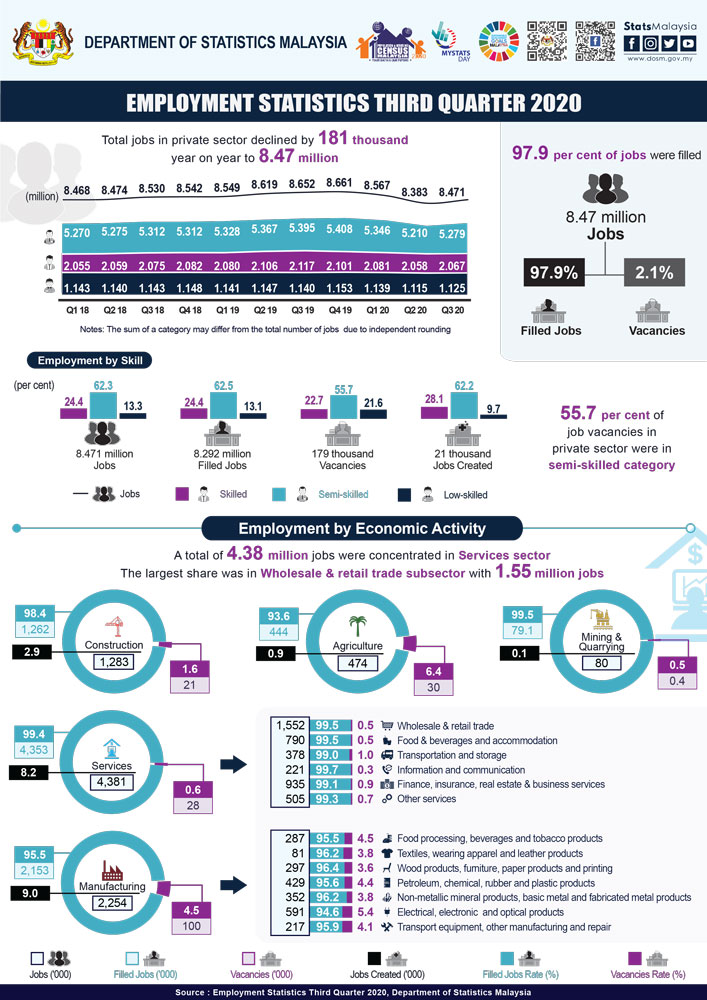The number of private-sector jobs in Malaysia grew slightly in the third quarter of this year following a precipitous drop in the previous quarter.
However, this may be cold comfort to those looking for work, as it is still 181,400 positions fewer than the same period last year.
According to employment data released by the Department of Statistics (DoS) today, the number of private-sector jobs stood at 5.57 million in the first quarter of the year, which was similar to last year, before the Covid-19 pandemic struck.
It fell by 2.13 percent to 8.38 million in the second quarter and grew 1.05 percent to 8.47 million in the third quarter. For comparison, there were 8.65 million positions available in the third quarter of 2019.
The DoS also reported that the number of new jobs created in the third quarter has picked up, compared with the previous quarter.
A total of 21,000 new private-sector jobs were available in the third quarter, compared to 21,900 in the first quarter and a mere 13,700 in the second quarter.
The figures appear to tally with the tightening and easing of movement control order (MCO) restrictions over the first nine months of the year.
The MCO was implemented nationwide beginning March 18 but was replaced with the more relaxed conditional MCO (CMCO) beginning May 4, which allowed most economic sectors to operate.
On June 9, restrictions on both the economic and social sectors were further relaxed under the recovery MCO (RMCO).
The impact of the reintroduction of the CMCO in most states would probably become apparent only in the fourth-quarter employment statistics, which is scheduled for release on Feb 9 next year.
The CMCO was reintroduced in Sabah on Oct 13; Kuala Lumpur, Putrajaya, and Selangor on Oct 14; Labuan on Oct 17; and all other states except Perlis, Pahang, Kelantan and Sarawak on Nov 9.

Some districts, sub-districts and localities had come under conditional or enhanced MCOs earlier, before the restrictions were implemented state-wide.
Meanwhile, the DoS figures also revealed that skilled and semi-skilled workers were hardest hit by the shrinking number of jobs, compared to last year.
The number of skilled jobs shrank from 2.12 million last year to 2.07 million, which is a fall of 2.3 percent or 50,200 positions compared to the third quarter of last year.
The number of semi-skilled positions available shrank by 2.14 percent to 5.28 million positions over the same period, which amounts to a net decrease of 115,700 jobs.
The number of low-skilled jobs, meanwhile, shrank by 1.27 percent to 1.13 million jobs – a net loss of 14,500 jobs.
In terms of the number of vacancies, the department said there are 179,300 positions waiting to be filled, or 2.1 percent of the available positions. This amounts to 40,700 skilled positions, 99,800 semi-skilled positions and 38,800 low-skilled positions.
“Vacancies were largely in the manufacturing sector with a share of 56.0 percent, followed by agriculture (16.8 percent) and services (15.5 percent). Meanwhile, job vacancies in the construction, as well as mining and quarrying sectors, were 11.5 percent and 0.2 percent respectively.
“In the meantime, nearly half or 42.9 percent of jobs were created in the manufacturing sector. The services sector ranked second with a share of 38.9 percent,” the DoS said. - Mkini




No comments:
Post a Comment
Note: Only a member of this blog may post a comment.